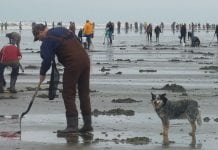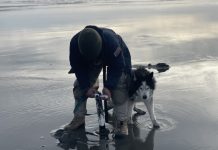Submitted by Washington Military Development
Fifty new tsunami sirens installed by the Washington Emergency Management Division have completed the statewide tsunami siren network and will help make the coast a safer place. These include 12 new sirens within Grays Harbor County as well as one with the Shoalwater Bay Tribe in Northern Pacific County.
The new All-Hazard Alert Broadcast (AHAB) sirens are filling critical gaps in the tsunami warning infrastructure. Without the funding from the Washington state Legislature and the hard work and dedication of partners across Western Washington, completing the siren network could have taken another 20 years.
There are now 122 sirens on the Washington coast, which are run and maintained by the state. The state installed the first siren in 2005, and over the next 15 years, brought that number to 72. The last 50 sirens took about two years to install, which is an unprecedented achievement. View a map of the sirens at this link.
New sirens include:
- Shoalwater Bay Tribe
- City of Aberdeen, West Hunley Street
- City of Aberdeen, Bishop Athletic Complex
- City of Aberdeen, Lafayette Street
- City Hoquiam, Queen Avenue
- Grayland Beach State Park
- Ocean City State Park
- Twin Harbors State Park
- City of Cosmopolis
- Ocean Shores, Central Water Reservoir
- Ocean Shores, Vacuum Pump Station #6
- Ocean Shores, Vacuum Pump Station #6
- City of Westport
This week, more than 100 stakeholders will conduct a seminar and workshop exercise looking at the threat a tsunami could have on Washington state. The sirens will not be activated during the exercise. It will take place virtually with assistance from federal, state, tribal and local government leaders, as well as emergency management, the private sector and other key coastal partners discussing tsunami alerting and response.
The AHAB tsunami sirens are intended to act as an outdoor tsunami alerting method for people and communities on or near the beach who may not otherwise have access to other official alerting methods via radio, TV or their smartphones. This is especially helpful for “distant” tsunami events from places like Alaska, Japan or Southeast Asia. The tsunami sirens are NOT meant to be heard inside. Residents should invest in NOAA Weather Radios to hear tsunami alerts while inside their homes.
The Washington Emergency Management Division coordinated with state, tribal and local partners to identify and fill the tsunami siren gaps for high risk communities. Local partners may decide on their own to add more sirens as the years progress.
“This life-saving project brought together state agencies, tribal, county and city emergency management as well as other important stakeholders to ensure Washington’s coastal communities can be alerted in the event of a tsunami warning,” said Maximilian Dixon, the geologic hazards supervisor for the state Emergency Management Division.
Dixon also highlighted the work of Robert Purdom of the Washington Emergency Management Division. Purdom has been directly in charge of the maintenance and installation of the sirens for many years and did unprecedented work to ensure the siren network was completed, choosing to delay retirement until he was able to see his job finished.
Dixon says the state’s attention now will be to improve tsunami evacuation route signage, as well as working with local officials on vertical tsunami evacuation structures.
FAQ
Why Sirens?
All 3,000 miles of Washington’s coastline are at risk of tsunamis. For local tsunamis, those caused by nearby earthquakes, the groundshaking is your warning that a tsunami could be on the way. However, for distant tsunamis, those caused by earthquakes in other parts of the world, there is no groundshaking to warn you about the approaching danger. Tsunami sirens therefore play an integral role in ensuring Washington’s public receives ample warning for distant events. The sirens have an audible range of approximately 1 mile, though this varies depending on environmental factors like topography, wind direction and physical barriers. The pole-mounted voice/tone sirens are also topped with a blue light for the hard of hearing. The sirens are not intended to be heard indoors.
Siren Testing
The siren system is tested on the first Monday of every month at noon. The sirens play the Westminster Chimes followed by an audio message in English and Spanish. The sirens are also tested once a year with the actual tsunami warning wail sound on the third Thursday in October in conjunction with the Great Washington ShakeOut earthquake and tsunami drill.
Know Your Tsunami Warning Signs
If you hear the siren wailing sound, or you receive a tsunami warning through your smartphone, TV, radio, or other alerting method, immediately follow the closest tsunami evacuation route inland or to high ground. This is your warning that a tsunami is approaching and you need to evacuate the inundation zone as soon as possible.
If you are on the coast and you feel ground shaking, drop, cover and hold on to protect yourself. When the shaking stops, immediately follow the closest tsunami evacuation route inland or to high ground. Do not wait to hear a tsunami siren or to receive an official tsunami alert – the shaking is your warning that a tsunami may be on its way.
To learn more about the AHAB tsunami siren network, and how you can prepare yourself and your loved ones for a tsunami, visit Washington Emergency Management website.











































